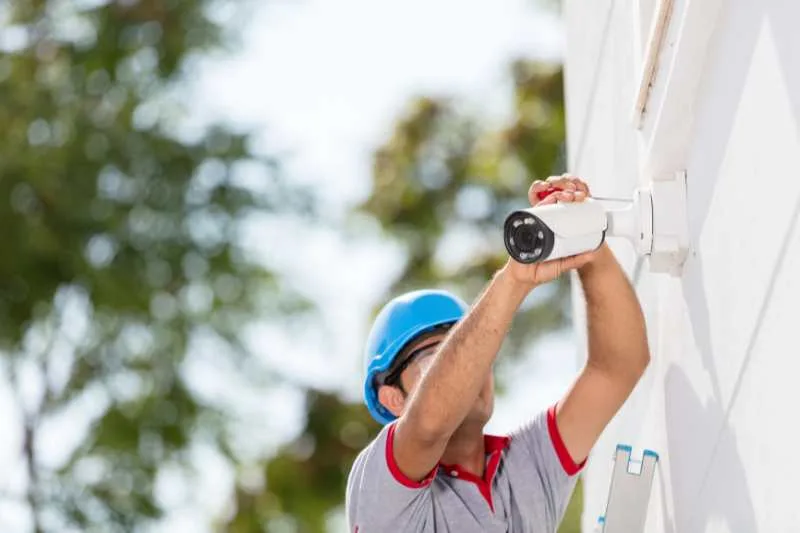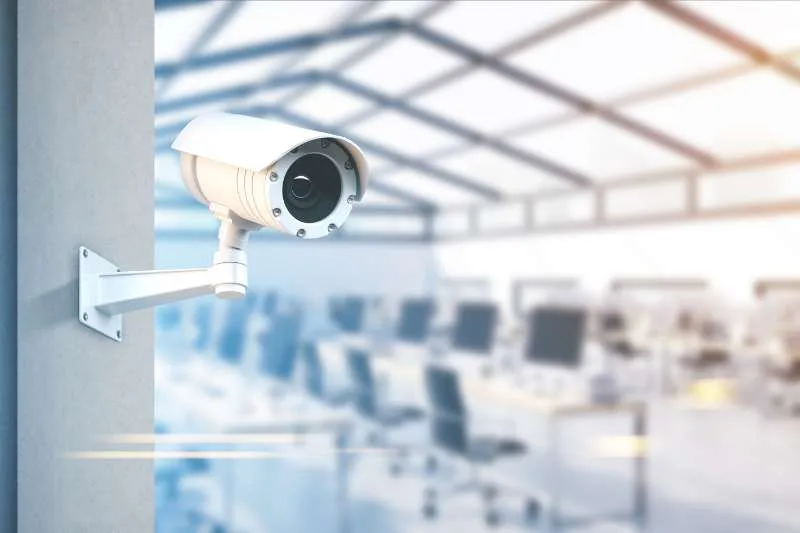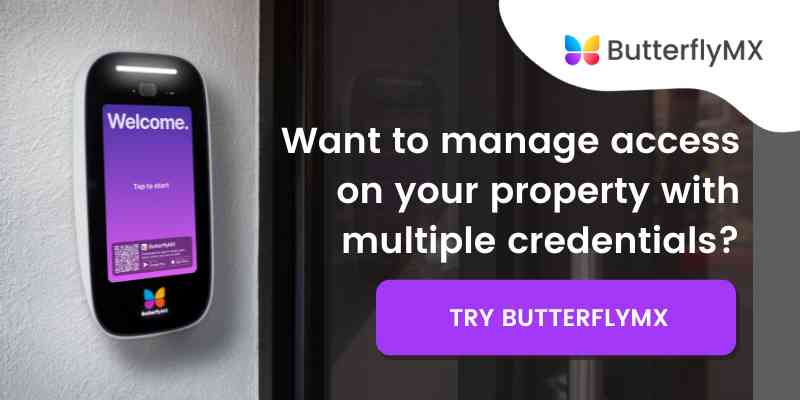Key takeaways
- Cloud security systems are security solutions whose devices connect to the cloud.
- A cloud security system stores data in the cloud instead of an on-site server.
- The components of a cloud security system include cloud-based cameras, access control systems, alarm systems, and motion detectors.
- The best cloud-based security solutions allow you to keep doors and gates locked without hindering access for authorized tenants, staff, and visitors.

Out of all the possible solutions to boost your property’s physical security, cloud security systems are one of the most intricate. Every building has unique needs, and this guide will help you determine whether cloud security systems are right for you.
First, we’ll cover what a cloud security system is. Next, we’ll go over how cloud storage works and why it’s useful. Finally, we’ll recommend the best cloud-based security system for your property.
This post covers:
- What is a cloud security system?
- How do cloud security systems work?
- Why is cloud security needed?
- What is the best cloud-based security system?
What is a cloud security system?
A cloud security system is a network of devices and security measures that stores sensitive information in the cloud and then encrypts it so that it can only be accessed by an authorized user. Cloud-based security systems eliminate the need to maintain and store data in an on-premise server.
Components of a cloud security system
A cloud security system is a network of connected devices used to improve physical security.
Components of a cloud-based security system may include:
- Cloud video surveillance cameras. By connecting to the internet, these cameras can instantly upload video footage to the cloud. Building staff can review the footage from anywhere, at any time.
- Access control systems. These systems control access to various spaces and range from video intercoms to keypads to elevator controls. They store data — including users’ access credentials and entry logs — in the cloud.
- Alarm systems. Thanks to cloud storage, you can review incidents that set off an alarm from anywhere. This is especially helpful if you’re not on-site and want to know if your alarm has been triggered.
- Motion sensors. Motion sensors go off when they detect movement. The sensor system can store incident data in the cloud, where building staff can review everything remotely.
Can you trust cloud security?
Yes, you can trust cloud security — as long as you do your own research and ensure you sign up with a trusted provider.
If you go with a cloud security provider, you don’t have to deal with setting up and maintaining cybersecurity infrastructure yourself. However, as a final test, you can see if a potential cloud security company has had any lapses or data breaches in the past.
How do cloud security systems work?
A cloud security system works by storing data such as security breaches, surveillance video footage, and user access credentials in the cloud — or, in other words, in a remote server. Cloud-based security systems require an internet connection to enable remote management. All of the devices in a cloud security system work together to keep people and assets safe.
If you’ve ever used a smartphone, you’re likely familiar with the term “cloud storage” as it can be used to back up your phone’s data, pictures, and videos. Cloud security systems work the same way by uploading and storing data in the cloud.
Watch how ButterflyMX works to improve security:
What are the different types of cloud storage?
The three main types of cloud security solutions are:
- Private storage. This type of cloud storage can only be accessed by building owners and property managers. Admins need a password with varying degrees of authentication.
- Public storage. Buildings can use public storage to allow tenants and businesses in the building to access information in the cloud without compromising security.
- Hybrid storage. As the name suggests, this system is a hybrid of both public and private cloud storage. Often one will protect sensitive data related to building security while the other allows users to upload less sensitive data, such as pictures of new designs for a front lobby.
How does a cloud security camera system work?
A cloud security camera system works by recording video footage and storing it in the cloud using an internet connection. You plug cloud cameras into an edge gateway device or a bridge, which reduces the required bandwidth.
In contrast to cloud cameras, a traditional, non-cloud-based security camera system stores video footage on a physical hard drive using a bulky on-site server and wired connections.

What are the benefits of a cloud-based security camera system?
Cloud-based security camera systems are one of the most common security solutions for a reason.
Benefits of a cloud security camera system:
- Cloud cameras can store vast quantities of videos and images in the cloud as opposed to an on-site server.
- If a cloud camera is damaged or the internet goes down, the data that it recorded is instantly backed up to the cloud.
- They help deter crime.
- You can manage the camera system remotely from anywhere.
- All you need is a bridge to connect the system to the cloud.
- Many cloud-based outdoor security cameras are weatherproof.
Do security cameras need cloud storage?
Security cameras don’t need cloud storage, but they do benefit from cloud storage. Cloud security cameras offer better data storage that’s more accessible through the internet than traditional cameras.
What are the best cloud-based security cameras for business?
Offices and businesses have distinct security needs. And security cameras are one of the best solutions to protect both assets and people.
The best cloud-based security cameras for businesses are:
- ButterflyMX. ButterflyMX’s Dome and Bullet Cameras are perfect for security indoor and outdoor areas — plus, administer our Cameras and our other access products, like Video Intercoms and Keypads, with the powerful ButterflyMX OS.
- Lorex. Lorex is an industry-leading security provider offering quality equipment and a wide range of security cameras for businesses of all sizes. However, there are no professional monitoring options — all activity monitoring is DIY. Also, you may need an NVR to connect their cameras to the cloud.
- ADT. If you operate a particularly large business with multiple locations, you may want to go with ADT for your security cameras. ADT offers various video surveillance packages that you can tailor to your business needs. However, ADT may not offer DIY monitoring options and may require you to commit to a three-year minimum subscription.
- Swann. Swann sells dozens of indoor and outdoor security cameras. Best of all, you can purchase multi-camera kits to ensure adequate surveillance coverage at your business. But keep in mind that you may need to pay a monthly fee for cloud storage.
- Arlo. Arlo’s sleek and modern-looking wireless security cameras may be ideal for small- to medium-sized businesses because they’re easy to install and set up. However, cloud storage may only be free with certain camera models.

What is cloud NVR?
Cloud NVR (network video recorder) is software that runs on an on-premise computer and connects to IP video cameras that store their data in the cloud. While NVRs don’t process video themselves, they do receive video footage from the IP cameras through an internet connection, usually an Ethernet cable.
In a way, cloud NVRs can be considered as a hybrid of on-site software and cloud-based data storage. With a cloud NVR in place, users can watch live and recorded video footage taken by all the cameras through the cloud. While you will need an on-premise computer, you won’t need an on-site server.
Traditional cloud-based video cameras connect directly to the internet, and the only on-site hardware needed is usually the cameras themselves.
Why is cloud security needed?
Cloud technology is the next evolution in security technology trends. We’ve already gone over how it can make your property more secure. But how does it benefit your online storage needs?
Here are some of the many benefits of cloud security:
- It can require different levels of access credentials, such as two-factor authentication, which makes data more secure.
- Many cloud security companies monitor their networks 24/7 for breaches.
- Cameras can stream live video.
- Patches are released online to improve security, squash bugs, and add new features. As a result, cloud security is always evolving.
- You don’t have to maintain an on-premise server.
- It’s cost-effective.
- Integrating with other security technology is easy.

What is the best cloud-based security system?
The best cloud-based security upgrade for your property is the ButterflyMX unified property access control system. ButterflyMX has been installed in more than 10,000 properties — and has more than 20,000 five-star ratings.
Together, our cloud-based access control solutions boost security and keep your property safe without hindering access or inconveniencing residents, staff, and authorized visitors.
The ButterflyMX property access control solution includes:
- Video Intercoms for secure visitor and delivery access at front entrances.
- Keypads and Card Readers to control access and maintain security within the building. These readers are also great for auxiliary building entrances.
- Elevator Controls to ensure that authorized visitors can only reach the floor of the person they’re visiting.
- Vehicle Readers to maintain secure access at gated vehicle entrances.
- Package Room to ensure secure deliveries and prevent package theft.
- Smart Lock integrations so that residents can enjoy secure yet convenient smartphone-based access to their units and amenity spaces.
Because our products operate with cloud-based software, staff can manage the entire security system from anywhere, any time. And there’s no need to maintain a bulky on-site server when everything’s stored in the cloud







